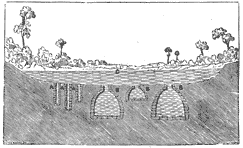
[This is taken from John D. Baldwin's Ancient America, originally published in 1871.]
No well considered theory of these ruins can avoid the conclusion that most of them are very ancient, and that, to find the origin of the civilization they represent, we must go far back into the “deeps of antiquity.” On all the fields of desolation where they exist, every thing perishable has disappeared. Wooden lintels are mentioned, but these can hardly be regarded as constituting an exception when the character of the wood, and the circumstances that contributed to their preservation, are considered. Moreover, wooden lintels seem to have been peculiar to Yucatan, where many of the great edifices were constructed in the later times, and some of them of perishable materials. Every where in the older ruins, nothing remains but the artificial mounds and foundations of earth, the stone, the cement, the stucco hard as marble, and other imperishable materials used by the builders.
If the edifices had all been made of wood, there would now be nothing to show us that the older cities had ever existed. Every trace of them would have been obliterated long before our time, and most of them would have disappeared entirely long before the country was seen by the Spaniards. The places where they stood, with no relics save the mounds and pyramidal platforms, would resemble the works of our Mound-Builders, and not a few “sound historical critics” would consider it in the highest degree absurd to suggest that cities with such structures have ever existed there. Under the circumstances supposed, how wisely skepticism could talk against a suggestion of this kind at Copan, Mitla, or Palenque! and how difficult it would be to find a satisfactory answer to its reasonings! Nevertheless, those mysterious structures have not wholly disappeared, and we can easily understand that there was a time when large areas connected with them were covered with buildings of a less durable character.
I have referred to a writer who maintains, with more vehemence than candor, that the Aztecs, and all the other people found in the country, were “savages” not greatly different from the wild Indians farther north, while he admits the significance and great antiquity of these ruins. His conception of their antiquity is somewhat extreme, for he says they must have existed “for thousands of years” when the Spaniards arrived. If he had maintained that civilized communities were there “thousands of years” previous to that time, developing the skill in architecture, decoration, and writing, to which the monuments bear witness, it might be possible to agree with him. Some of us, however, would probably stipulate that he should not count too many “thousands,” nor claim a similar antiquity for the ruins now visible. It is not easy to suppose that any of these old monuments, with their well-preserved sculptures and inscriptions, represent the first period of the ancient history they suggest, nor that they have existed as ruins many “thousands of years,” for the climate of Mexico and Central America does not preserve such remains like that of Egypt.
Nevertheless, some of them must be very old. The forest established since the ruin began, the entire disappearance of every thing more perishable than stone, the utter oblivion which veiled their history in the time of Montezuma, and probably long previous to his time, all these facts bear witness to their great antiquity. In many of them, as at Quirigua and Kabah, the stone structures have become masses of debris; and even at Copan, Palenque, and Mitla, only a few of them are sufficiently well preserved to show us what they were in the great days of their history. Meanwhile, keep in mind that the ruined cities did not begin their present condition until the civilization that created them had declined; and, also, that if we could determine exactly the date when they were deserted and left to decay, we should only reach that point in the past where their history as inhabited cities was brought to a close.
Take Copan, for instance. This city may have become a ruin during the time of the Toltecs, which began long before the Christian era, and ended some five or six centuries probably before the country was invaded by Cortez. It was built before their time, for the style of writing, and many features of the architecture and ornamentation, show the workmanship of their predecessors, judging by the historical intimations found in the old books and traditions. We may suppose it to have been an old city at the time of the Toltec invasion, although not one of the first cities built by that more ancient and more cultivated people by whom this old American civilization was originated. The present condition of the monuments at Quirigua is still more suggestive of great age.
Copyright © D. J. McAdam· All Rights Reserved